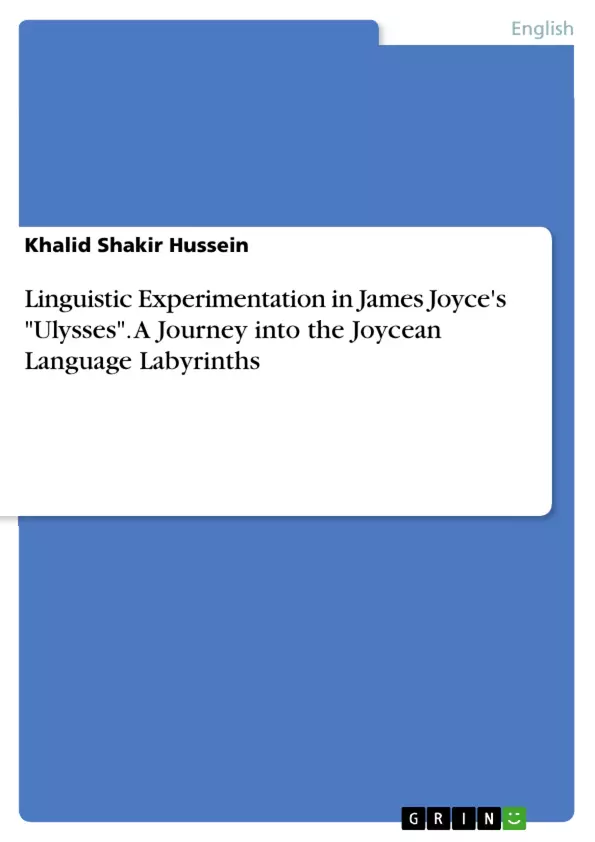This book aims at surveying the most outstanding dimensions of Joyce's aesthetic employment of language and investigating some of the technical difficulties ascribed to such an artistic employment.
Many attempts have been made to assimilate the enormous linguistic revolution set by Joyce through Ulysses. Nonetheless, it is not that much easy to cope with the innovative aspects of the experimental and pioneering linguistic techniques involved especially by those who are not qualified enough with the pervasive side of Joyce' linguistic experimentation.
The linguistic features of Ulysses are entirely new, innovative and often misunderstood. The moment it has been published it has stirred up so many critics to comprehend what Joyce has achieved altering the traditions of narrative writing once and forever.
Inhaltsverzeichnis (Table of Contents)
- PREFACE
- INTRODUCTION
- CHAPTER ONE
- LINGUISTIC EXPERIMENTATION: THE TWENTIETH CENTURY
- 1.1 THE RELIGIO-POLITICAL SCENE
- 1.2 THE SOCIAL SCENE
- 1.3 THE PSYCHOLOGICAL SCENE
- 1.4 THE PHILOSOPHICAL SCENE
- CHAPTER TWO
- DEVELOPED TRADITIONAL TECHNIQUES
- 2.1 INTERIOR MONOLOGUE
- 2.1.1 INDIRECT INTERIOR MONOLOGUE
- 2.1.2 DIRECT INTERIOR MONOLOGUE
- 2.2 SOLILOQUY
- CHAPTER THREE
- INNOVATED EXPERIMENTAL TECHNIQUES
- 3.1 FREE ASSOCIATION
- 3.2 SCENIC MONTAGE
- 3.3 STYLISTIC MONTAGE
- 3.4 TYPOGRAPHICAL TECHNIQUE
- 3.5 RHETORICAL TECHNIQUE
- CHAPTER FOUR
- EXPERIMENTAL LINGUISTIC REFRAIN
- 4.1 SYLLABIC REFRAIN
- 4.2 WORD REFRAIN
- 4.3 PHRASE REFRAIN
- CONCLUSIONS
- REFERENCES
Zielsetzung und Themenschwerpunkte (Objectives and Key Themes)
This book delves into the groundbreaking linguistic revolution initiated by James Joyce in his novel "Ulysses." It aims to provide a thorough analysis of the innovative and often misunderstood linguistic techniques employed by Joyce, examining the technical difficulties and artistic brilliance behind his unique language. The book explores the context of Joyce's experimentation, including the sociopolitical, psychological, and philosophical influences of the early 20th century. It investigates specific techniques like interior monologue, free association, montage, and linguistic refrain, shedding light on how Joyce used these tools to express psychological impressions and capture the complexities of human thought.
- Linguistic experimentation in 20th-century literature
- Analysis of Joyce's innovative language techniques
- The role of interior monologue and other experimental techniques in "Ulysses"
- The artistic and technical challenges associated with Joyce's linguistic approach
- The relationship between Joyce's language and the psychological dimensions of his characters
Zusammenfassung der Kapitel (Chapter Summaries)
The first chapter provides a foundation for the book, introducing the major themes and questions that will be addressed. It examines the sociopolitical, cultural, psychological, and philosophical landscape of the early 20th century, setting the stage for the emergence of linguistic experimentation. Chapter two delves into traditional techniques that Joyce employed, focusing on interior monologue and its variations, including indirect and direct interior monologue, as well as soliloquy. The third chapter expands on the exploration of experimental techniques, analyzing free association, scenic and stylistic montage, typographical techniques, and rhetorical techniques used by Joyce in "Ulysses." Chapter four introduces linguistic refrain as another experimental technique employed by Joyce, revealing how he used syllabic, word, and phrase refrain to convey divergent psychological impressions.
Schlüsselwörter (Keywords)
The book focuses on the unique and experimental language of James Joyce's "Ulysses," examining techniques such as interior monologue, free association, montage, and linguistic refrain. Key themes include the influence of 20th-century intellectual and social movements on Joyce's writing, the artistic and technical aspects of linguistic experimentation, and the relationship between language and psychology in the novel.
- Quote paper
- Khalid Shakir Hussein (Author), 2022, Linguistic Experimentation in James Joyce's "Ulysses". A Journey into the Joycean Language Labyrinths, Munich, GRIN Verlag, https://www.grin.com/document/1281367



